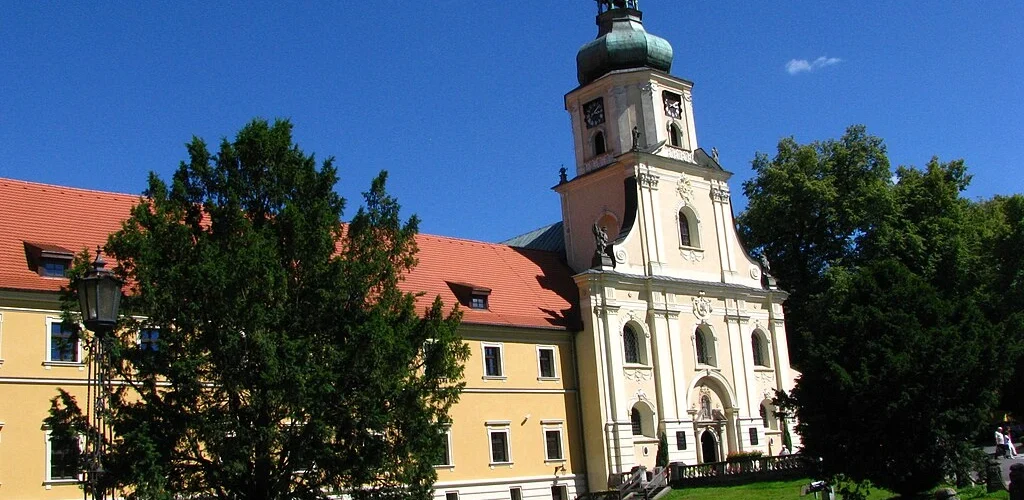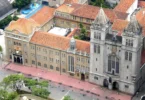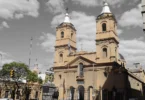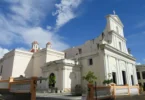Introduction
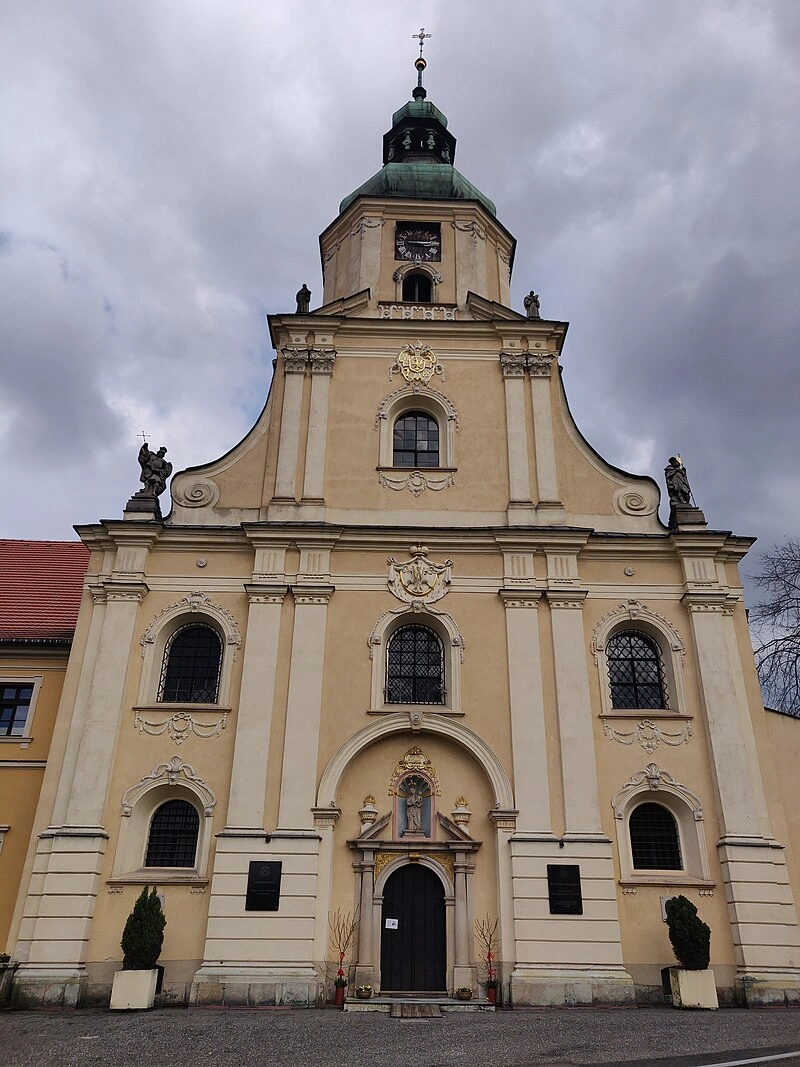
Rudy’s Basilica of the Assumption of the Blessed Virgin Mary is a very old church that dates back to the 13th century. It used to be a big Cistercian abbey, and when you go there, you can still feel like you’re in an old monastery. The location is now a training and education center run by the diocese of Gliwice as part of a larger complex that also includes a palace and what is left of the old monastery. It is still the primary church for the local parish, so it’s not just for show. It has been a special place for people to pray to Our Lady of Rudy, also known as “the Humble One,” since 1995. A lot of people in the area have a strong bond with her. In addition, the church was officially designated a minor basilica in 2009, which is somewhat significant in the context of churches. The basilica is still very much alive despite all of its history. People go there for Mass, for quiet reflection, and just to take in the beauty and peace of the place.
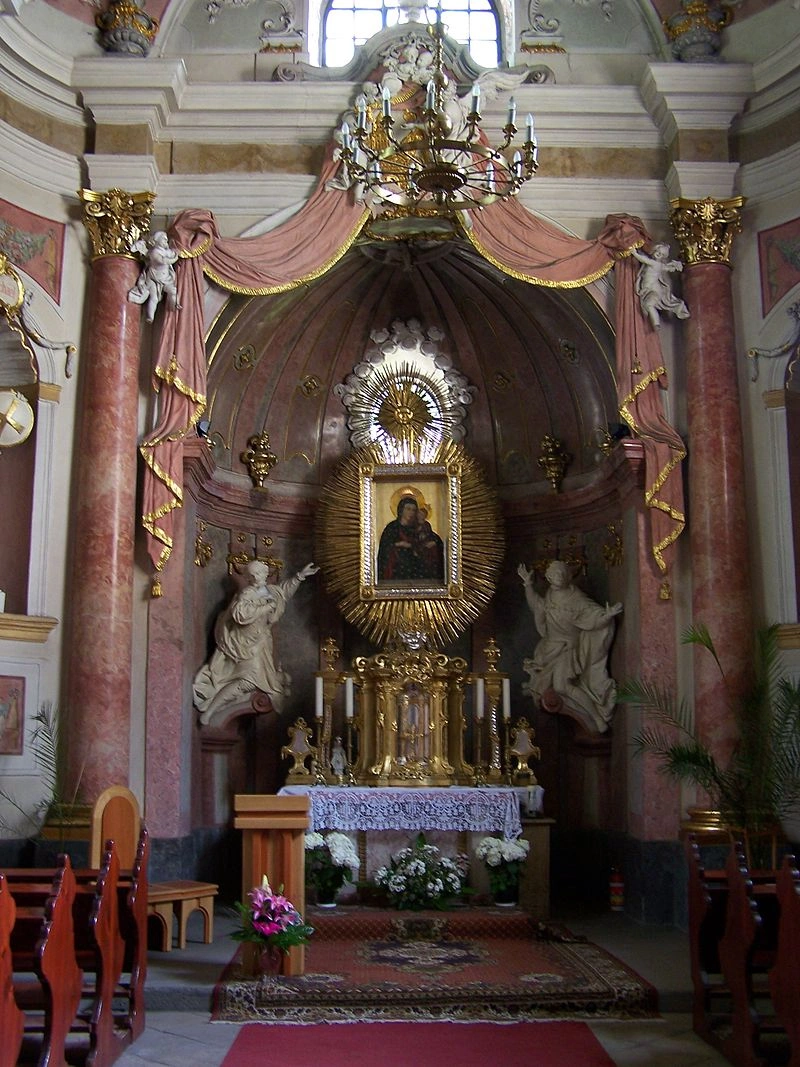
The history of the Basilica of the Assumption of the Blessed Virgin Mary in Rudy is inextricably linked to the history of the Cistercian abbey, which was established in the area in the mid-13th century. Soon after the first monks from Jdrzejów arrived in Rudy, the Cistercians constructed the first temporary church, probably made of wood. Construction of the next church, which still stands today, began after the entire convent was brought to Rudy around 1300. The church was dedicated in the year 1303 and was constructed in the Gothic style with Romanesque elements. In the 17th and 18th centuries, the church, with its medieval architecture, underwent reconstruction. In 1685, a porch with a new entrance portal was added to the original facade. The Cistercian burial crypt and Chapel of the Blessed Virgin Mary were also constructed between 1723 and 1726. At the end of this expansion, a large fire broke out. A new façade was constructed over the porch in 1725 as part of the reconstruction of the damage that had occurred, completely obscuring the façade that had been constructed four centuries earlier. Additionally, a brand-new sacristy was constructed at this time, the church’s walls were raised by approximately one meter, and a brand-new roof was installed over the entire structure. In 1945, the church was once more destroyed. The Red Army set fire to the abbey, which resulted in this. A thorough reconstruction of the church began in 1947, and renovation work continued in stages until 2000. The first step in the reconstruction process was to remove the plaster, which revealed the interior’s original Wendish brickwork. The windows were rebuilt, the arcades between the naves, which were expanded during the Baroque period, were rebuilt, and the vaults were rebuilt. The Chapel of Our Lady served as the setting for the church’s first post-war mass in 1950. In the years 1989–1992, the historic chapel of Our Lady of Humble was renovated, and in the years 1994–1996, a general renovation of the tower façade and church walls began. In 1998, a new chapter in the church’s history began with the transfer of the Ruda Abbey to the Gliwice Diocese. The church and the abbey have both begun to regain their former splendor since then. Jan Wieczorek, Bishop of Gliwice, designated the diocesan church as the Sanctuary of Our Lady of Ruda by decree dated May 28th, 1995. Archbishop Józef Kowalczyk, at the time Apostolic Nuncio to Poland, consecrated the painting on June 4, 2000, with papal crowns consecrated on June 17, 1999, in Gliwice by John Paul II. Benedict XVI elevated the church to the status of minor basilica on June 14, 2009, which marked the 750th anniversary of the abbey.
Architecture of Basilica of Our Lady of Humbleness, Rudy, Poland
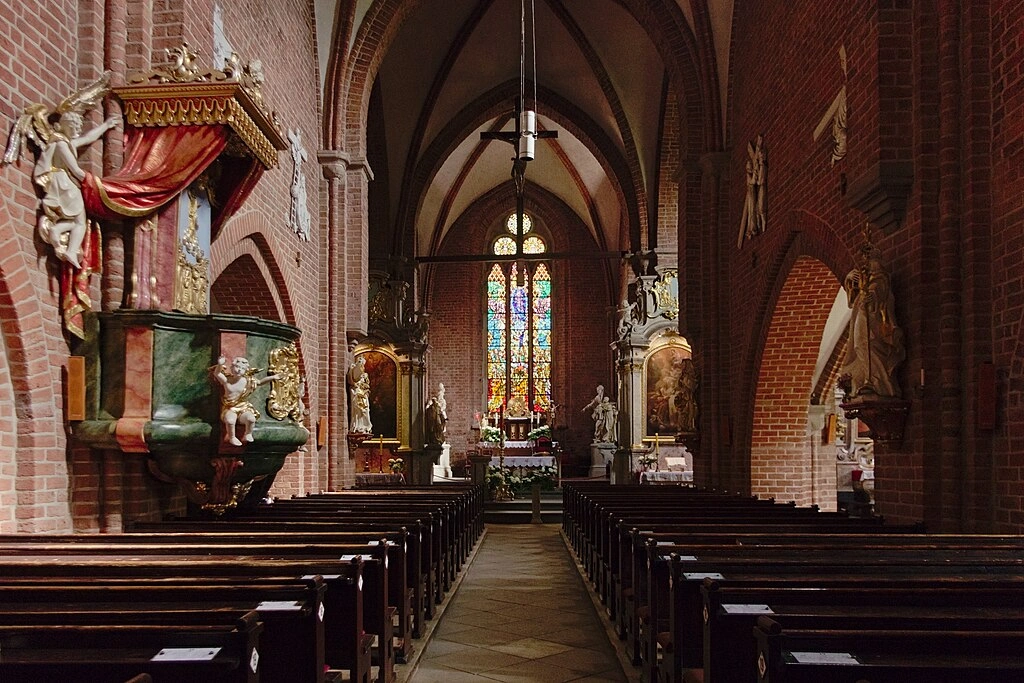
Architectural style: Gothic architecture
The monastery church, one of the largest churches in Silesia at the time of its construction, was built of brick with sandstone in the structural sections. The church is set up like a Latin cross. The basilica has three aisles, with the main nave being higher than the side aisles and being directly lit by windows with pointed arches in its upper part. The windows in the side aisles are similar. Cross-ribbed vaults cover the naves. In keeping with the original layout of the Jdrzejów abbey, the chancel and sidechapels that are next to it were constructed on a square plan. The chancel window has a tracery-covered opening that is significantly larger than the other windows. In both the main nave and the side aisles, bays of the same length make up the vault. Romanesque architecture is characterized by this arrangement. The remaining architectural components of the church are characterized by the Gothic style. The Cistercian church had no towers when it was first built. The entrance portal was the main part of the facade. Because a porch was added at the end of the 17th century, you can still see it in the church’s porch. A statue of Mary and the Child occupies a semicircular niche at the top of the portal over the main entrance. A two story screen wall and a tower that is partially hidden behind it are the features of the new Baroque façade, which was the result of a subsequent church reconstruction. The tower is a characteristic component of Central European churches and the façade’s stories, which are of equal width, echo the shape of the Roman Church of Il Ges, a model for many churches in Europe.
The façade features four figures: two above the first story Archangel Michael on the left and St. Florian is located to the right, and two are St. Benedict and St. Bernard.The south side of the church got a Baroque chapel dedicated to the Blessed Virgin Mary in the 18th century. A southern wall with chamfered corners houses a semicircular altar apse, enclosing the chapel on a rectangular plan. At the corners of the chapel are four shell niches, framed by columns, in which are placed statues of the archangels Michael, Gabriel , Raphael , and the Guardian Angel, made by Jan Schubert of Lipnik nad Beczawą. In addition, Schubert’s sculptures of the Raciborz princes, Casimir and Wadysaw, can be found in the chapel. A master locksmith from Racibórz constructed a metal grate that was modeled after the grate at Henryków Abbey to separate the chapel from the church. The side chapels, which are next to the chancel, are for St. The Holy Cross and John of Nepomuk A dome and frescoes make up the dome of the John of Nepomuk Chapel. Additionally, it retains stucco work from the 18th century. Polychrome wallpaper from 1775 decorates the Holy Cross Chapel. Additionally, the chapel contains the epitaph slabs of Abbot Andrzej Pospal and Prince Wadysaw. The first is made of wood, while the second is made of stone and has a bas-relief.
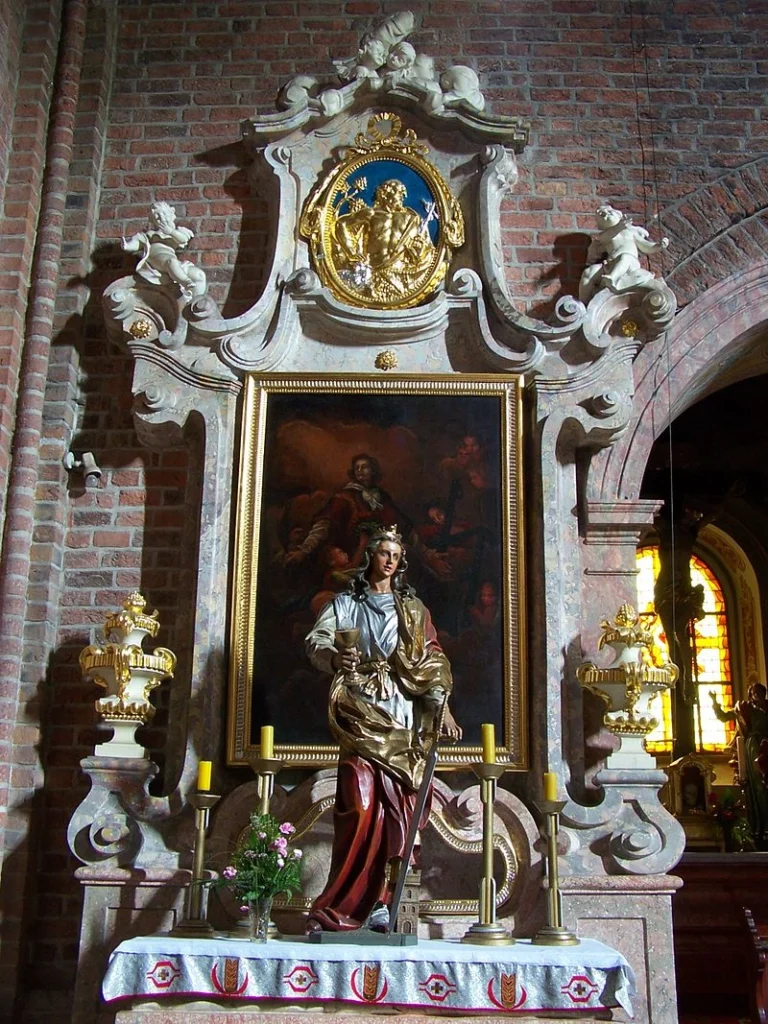
Equipment
In 1945, a fire largely destroyed the furnishings of the basilica. Only the chapel decorations on the transept’s southern extension and near the chancel survived in relatively good condition. Only the anti-pulpit in the nave and four side altars along the transept’s eastern wall remain from the original furnishings. The current pulpit is not a replica of the one that was destroyed in the fire in 1945. In the northern arm of the transept is a stone portal from 1680 with the IHS monogram at the finial. There are two types of side altars. The first is a sarcophagus altar that is connected to a volute frame that is mounted on a high plinth. Volute consoles with stucco vases adorn the lower section. A glazed container for relics is placed between the consoles. Reliefs in the shape of an oval made of wood cover the altars. These altars contain paintings of St. Florian and St. Lawrence, whereas the reliefs portray Saint Joseph with the infant Jesus and St. John the Baptist, respectively. The second kind of side altars are structures with pillars on the sides and high plinths that are diagonal to the altar’s plane. On consoles in the lower part of the altars, saintly stucco figures are placed. These are Jan Melchior sterreich sculptures of Moses, Aaron, John the Baptist, and John the Evangelist, all of which were restored in 2000. The sculptures on the façade of the basilica are also by Austria. Putti are seated on volutes on the lower portion of the altar finials. There are paintings on the altars. St. Bernard’s death and Bernard Benedict, and a representation of Isaac’s sacrifice and an image of the Queen of Sheba standing before King David at their finials. The anti-pulpit has the same shape as the pulpit on the opposite side of the nave. The pulpit’s basket is widened at the bottom, and the canopy is rectangular in polychrome stucco, imitating drapery. The front wall of the basket depicts the scene of Jesus’ meeting with the disciples at Emmaus, while the back of the pulpit depicts a scene in which St. Bernard of Clairvaux converts William of Aquitaine, an enemy of the papacy, with the Host. Anti-pulpits most often served as a superstructure for the baptismal font or a side altar. The sole saintly remains are housed in the basilica. Valentine in Silesia, as well as relics of the True Cross. The 19th-century cast-iron sarcophagus of Prince Victor and his wife can be found beneath the crypt of the Racibórz princes from the Hohenlohe Schillingsfürst family in the porch.

Sanctuary
The Rudy sanctuary’s history is connected to the image of Our Lady, also known as the Humble One. The image of Mary was brought from Jdrzejów by Cistercians. The Dukes of Racibórz, Casimir and his son Wadysaw, presented the image to the Cistercians. Rudy’s devotion to the Marians began when the image first appeared in his life. The prayers that were written here, among other things, are evidence of this. However, the most popular form of devotion to the image of Our Lady of Rudy, known from historical records, were pilgrimages. They came from all over Silesia, Lesser Poland, and the Czech Republic in addition to the immediate area. Preserved lists of votive offerings and copies of the Rudy image painted at that time are testimony to these times. Rudy became Silesia’s oldest Marian devotional site. The 17th and 18th centuries saw an increase in the cult of the Rudy sanctuary. The Thirty Years’ War is the first time a miracle caused by Mary’s intercession has been recorded. In 1642, when Protestant troops were approaching the monastery, the monks took the image and went in procession to the church. The Swedes became perplexed and fled from the monastery when a fog formed over it. In the first half of the 18th century, the pilgrimage movement reached its highest point. During this time, the most votive offerings were made. Also built for the image was a Marian chapel. The pilgrimage movement came to an end when Silesia was taken over by Prussia. After secularization in 1810, the cult of the image weakened, but did not disappear. The princes von Ratibor, Rudy’s owners, imposed a ban on pilgrimages to demonstrate its severity. This contributed to limiting the cult to a local character. The church of the monastery burned down in 1945, but the chapel with the amazing painting survived. The locals saw this as a reminder of Mary’s special protection over this location. The church was rebuilt after the war, but pilgrimages were banned by communist authorities. Only in 1974, Bishop Franciszek Jop of Opole designated the church as a sanctuary during the Holy Year celebrated at that time. The Marian chapel’s renovation was finished in 1992, and the church was made a diocesan sanctuary in 1995. The number of pilgrimages increased as a result. The coronation of the painting of Our Lady of Humbleness with papal crowns consecrated by John Paul II in 1999 contributed to its further revival. Since then, the sanctuary has once again attracted pilgrims from further and further corners of Poland and Europe.

The image of Our Lady of Humbleness
One of the most treasured parts of the sanctuary is the miraculous painting of Our Lady of Humbleness. It is about 114 by 73.5 centimeters in size and was painted in tempera on a linden wood board around the middle of the 15th century. It is probably a copy of a painting from the early 1200s that is even older. Princess Viola may have brought the original Byzantine style painting, which was probably painted, to Silesia. She was the daughter of a Bulgarian tsar, and the story goes that Prince Casimir met her on his way back from the Holy Land, married her, and she brought the painting with her. It is believed that the first painting was destroyed during either the Hussite attacks on the monastery in the year 1400 or the Reformation a century later. The painting that is still in existence today depicts Mary with the infant Jesus on her left arm, just above her waist. With one hand extended in a blessing and a book in the other, the Child looks at Mary. It is painted in a style that is clearly influenced by Byzantine icons, and some believe that it may even be based on the well-known Roman painting of Our Lady of the Snows (Salus Populi Romani), which is located in the church of St. Roman Mary Major. The painting has been restored multiple times over the years, and it has been repainted four times. The last big restoration before World War II was in 1935, done by Hugo Hesse, a painter from Wrocław. At that time, both Mary and Jesus were crowned, and the original image was covered in silver robes. The metal crowns and robes were copied following the conservation work. The painting was then meticulously restored once more in 1990–91, this time by Magorzata Schuster-Gawowska of the Kraków Academy of Fine Arts. The oldest, Gothic version of the Virgin and Child that had been hidden beneath all of the later layers was brought back thanks to this conservation.
Feast Day
Feast Day : 15 August
The feast of Our Lady of Humbleness at the Basilica in Rudy is celebrated every year on August 15th. The day includes special prayers and processions, bringing together locals and pilgrims. It is a vibrant celebration of faith and devotion to the Blessed Virgin Mary.
Church Mass Timing
Monday to Saturday : 07:00 AM, 05:30 PM
Sunday : 07:00 AM, 09:00 AM, 10:30 AM, 12:00 PM, 04:00 PM, 07:00 PM
Church Opening Time:
Monday : Open 24 hours
Tuesday to Sunday : 6:30 am – 6:00 pm.
Contact Info
Address : Basilica of Our Lady of Humbleness
Cysterska 1, 47-430 Rudy, Poland.
Phone : +48 32 410 30 57
Accommodations
Connectivities
Airway
Basilica of Our Lady of Humbleness, Rudy, Poland to Katowice International Airport, distance 57 min (76.8 km) via A1.
Railway
Basilica of Our Lady of Humbleness, Rudy, Poland to Kuźnia Raciborska station, distance between 12 min (11.3 km) via DW425.

